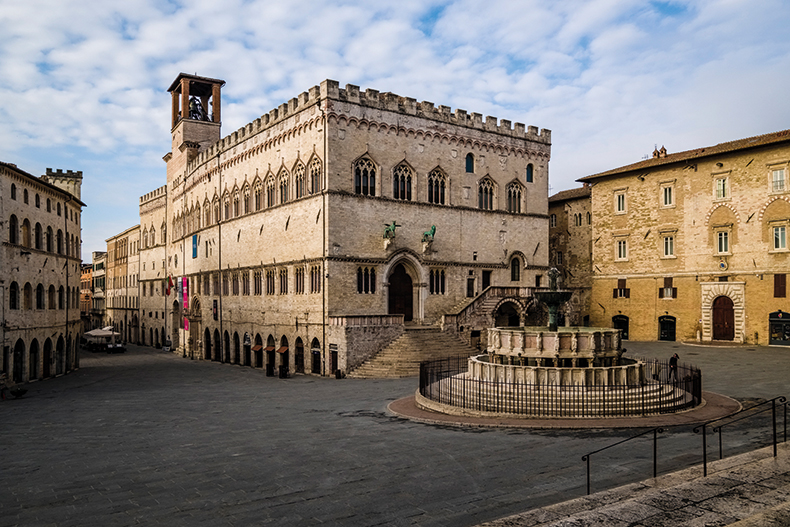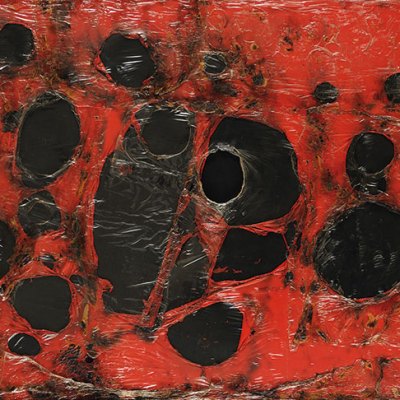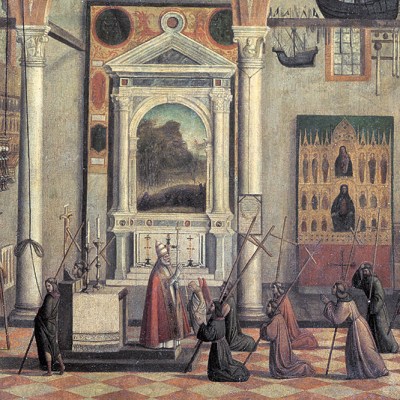From the September 2022 issue of Apollo. Preview and subscribe here.
The Galleria Nazionale dell’Umbria (GNU) in Perugia is, says its director Marco Pierini, ‘the most national civic museum in Italy’. It is a neat formulation for an institution otherwise hard to define. The GNU is undoubtedly one of Italy’s great museums, but an entirely different creature from, say, the Uffizi, the Brera, the Vatican or the Capodimonte. It too has spectacular holdings but its collection is smaller, more wedded to its region, more specifically Italian and is particularly rich in trecento and quattrocento art – not necessarily the most come-hither periods for the majority of museum-goers.
To add to its distinctiveness, the GNU’s collection comprises almost exclusively religious art and objects – there is very little by way of history painting, portraiture, landscapes or genre scenes – and is largely drawn from churches across a swathe of Umbria, Tuscany and Le Marche. This geographical and thematic rootedness gives it a highly individual flavour. Consequently, says Pierini, ‘Perugians feel this is their museum’ – a sentiment not necessarily inspired in the citizens of Florence, Milan, Rome and Naples by their more international and encyclopaedic galleries.
Built in the 13th century, the Palazzo dei Priori in Perugia now houses the Galleria Nazionale dell’Umbria. Photo: Frank Bienewald/LightRocket/Getty Images

Where the museum is particularly fortunate is in its site. It occupies the third floor of the Palazzo dei Priori (‘Palace of the Priors’), a civic structure dating back to the late 13th century. It sits just below the duomo on the Corso Pietro Vannucci, the amblers’ boulevard that runs the length of the crest of the hill on which the city is built: Pietro Vannucci is better known as Perugino (c. 1450–1523), Perugia’s most celebrated artistic son. The gallery has been in situ since 1879; before that it occupied parts of the former Olivetan monastery of Montemorcino Nuovo, while the collection itself grew out of the Accademia del Disegno which was founded in the city in 1573. In 1918, the GNU became a state museum and in 2015 the Ministry of Culture granted it autonomous status.
For all this, the gallery was, until recently, an unprepossessing place to visit, with a beige and tired air. Over the past 13 months, however, courtesy of a state grant of €5million, the GNU has had a revamp. All 37 gallery rooms have been refurbished and it has also gained new conservation facilities, a lecture room and a 30,000-volume public library. The latter occupies rooms given by the mayor, whose offices take up the first floor of the palazzo. ‘He’s looking over his shoulder,’ says Pierini wryly. ‘We want it all.’
Pierini, an expert on the early 14th-century Sienese painter Simone Martini, started to think about the changes shortly after his arrival in 2015; work started in June 2021 and was finished just 13 months later, in time for the gallery to reopen on 1 July 2022. Alterations to the fabric of so venerable a building were minimal but, ‘There were three different types of wood in use previously,’ Pierini says. ‘Too many different coloured marbles, too much metal.’ So he simplified the colour scheme to a very pale grey for the walls and removed the polish from the terracotta floor tiles to reduce reflections and let their warm golden tones show through. ‘We wanted to have views,’ he says, ‘but not UV rays or too much light. I wanted to see the town – it’s our context, it’s where the art comes from,’ so the windows were uncovered and veiled in a fine translucent mesh. He also clarified the signage, pared back the exhibits – from 300 to around 220 (from a collection of some 3,000 pieces) – and reduced the number of vitrines and partitions. Rather than displaying goldwork, metalwork and ivories together – en masse, they were ‘overwhelming, the visitor was lost’ – he has put the choicest examples alongside the paintings. Importantly, Pierini and his team decided on a chronological hang and a single route through the displays.
The gallery is now lighter, calmer and more coherent, which, Pierini hopes, will help prompt a significant rise in visitor numbers. When he arrived, the museum attracted 48,000 visitors annually; in 2019 – the last year before lockdown – that had reached 96,000, and he’d like it to rise to 120,000. To that end, the art is bolstered by a buzzing roster of concerts, lecture programmes, life-drawing classes and partnerships with Perugia’s many music festivals.
Crucifix (1272), Master of Saint Francis. Galleria Nazionale dell’Umbria, Perugia.

The changes are obvious from the first room, when the visitor emerges from the staircase to be met by the extraordinary, five-metre-high crucified Christ painted by the Master of Saint Francis in 1272. The painter was active in the lower basilica at Assisi – a mere 25 kilometres from Perugia – and worked in a style that fused the gothic and the Byzantine. The crucifix came from the church of San Francesco al Prato in Perugia and is so big that when it was moved into the gallery in 1863 one of the arms had to be cut off to make it fit.
Stylistically, it is notable for using more colour than gold; for the curve of Christ’s body indicating the slump of impending death; and the fall of his head on to his shoulder, all of which became Umbrian characteristics in later portrayals of the subject. The crucifix is suspended at an angle from the wall, which makes the suffering in the image all the more affecting, since the body leans over the viewer giving it an intense physical presence.
Most importantly from an art historical perspective, however, is the presence of a tiny figure of Saint Francis at Christ’s feet. He is presented as alter Christus – ‘another Christ’ – bearing the five marks of the crucifixion that mirror Christ’s own. The saint had died some 50 years before the painting was made and the stigmata that divinely pierced him in 1224 were a vital element in spreading his cult. It was a point of difference played down by the adherents of Saint Dominic, a contemporary of Francis, whose acolytes were building his own following in the mid 13th century. The Perugia crucifix has a role in this dispute: it is the first image in art to represent Saint Francis bearing the stigmata, a motif that quickly became widespread, not least in Giotto’s celebrated fresco in the upper basilica at Assisi. The Master of Saint Francis reinforced the point in one of the panels of the predella that accompanied the crucifix and that are displayed next to it; there, a scene of Deposition bears the words: ‘I am nailed, just like Christ.’ The crucifix is, therefore, not just an image to invoke piety but a work of divine propaganda.
Like many of the works in the gallery, the predella stands on what appears to be a solid grey metal plinth. In fact, each opens up to reveal a roller mechanism that allows the paintings to be pulled away from the wall for cleaning and technical analysis. The idea was Pierini’s and the mechanism was designed by a local architect. These plinths, says Pierini, are the only ones in the world, and he hopes to use them later for an exhibition of the backs of early panel paintings and the story they tell about construction and restoration over the centuries.
The gallery is also free of ropes and often glass in front of the paintings, too. It was a conscious decision to allow the visitor to get as close as possible to the artworks. ‘It is a risk,’ Pierini concedes, ‘but we trust in people.’ And this unwillingness to distance the viewer holds true even in the case of the gallery’s three greatest paintings: Duccio’s Madonna and Child with Six Angels (1304–10), Gentile da Fabriano’s Madonna and Child Enthroned with Angels (c. 1405), and Piero della Francesca’s staggering confection of celestial registers, the Polyptych of Sant’Antonio (c. 1467–69). The ability to get nose-close to these works is part of the gallery’s intent to keep them active, not just as works of art but as aids to meditation.
It is a point reinforced by the fact that the former Chapel of the Priors – part of the first suite of galleries – remains a consecrated space and services are held there a couple of times a year. Running round the upper walls, the room also holds a fresco cycle by Benedetto Bonfigli, started in 1454 and depicting scenes from the lives of Saint Herculanus and Saint Louis of Toulouse, two figures important to the city. The frescoes are Perugia’s equivalent of Ambrogio Lorenzetti’s The Allegory of Good and Bad Government (1338–39) in Siena, and Benozzo Gozzoli’s frescoes of c. 1459 for the Magi Chapel in the Palazzo Medici Riccardi in Florence. Bonfigli’s pictures, though far from complete, nevertheless show a detailed rendering of Perugia in the mid 15th century, including the Palazzo dei Priori itself.
Adoration of the Magi (1475), Perugino (Pietro di Cristoforo Vannucci). Galleria Nazionale dell’Umbria, Perugia

The most heavily represented artist in the gallery is, needless to say, Perugino. Previously his work had been spread through seven rooms; now he has two devoted entirely to him: the first shows the initial 25 years of his career, the second the remainder; subsequent galleries deal with his pupils Pinturicchio and Raphael and his legacy. This rationalisation is a means of stressing Perugino’s importance, which is too often eclipsed by Raphael.
He can appear too formulaic a painter for some tastes, with his lucid colouring and figures with a uniform sweetness of expression, but, says Pierini, at his best he was a great painter – ‘the best master of Italy’, according to Agostino Chigi, Croesus-rich banker and later patron of Raphael. Perugino trained alongside Leonardo in Andrea del Verrocchio’s workshop, was also taught by Piero della Francesca, and worked in the Sistine Chapel for Sixtus IV. Pierini is planning a major monographical exhibition for 2023 with loans from, among others, the Uffizi, the National Galleries in London and Washington, DC and the Gemäldegalerie in Berlin.
Why it will be worth visiting is evident in the gallery’s pictures. As well as a series of altarpieces (one of which includes a self-portrait showing him with red cheeks, possibly a sign of lupus), there are two cartoon drawings, a series of eight panels that may once have formed a door surround, a poignant small panel of the risen Christ in his tomb from 1495 (with a black background showing the effect of a recent visit to Venice) that was painted for the Chapel of the Priors, and a wonderful Annunciation that reprises the figures from the slightly earlier Annunciation of Fano but places them in an elegant and airy architectural space that clearly shows the influence of Piero della Francesca.
Although the GNU doesn’t own a work by Raphael, who was in the city certainly by 1503, it does hold some near contemporary copies of his Deposition (1507; now in the Borghese Gallery in Rome) painted for the Baglioni overlords of Perugia, and a ‘half Raphael’, Domenico di Paride Alfani’s Sacred Family (1510), created directly from a detailed gridded drawing sent to him by his famous friend in Rome.
Highlights among the collection’s later works are thinly spread, although Piero di Cosimo’s emotive Pièta of c. 1510 stands out, as do Valentin de Boulogne’s potently stygian Apparition of Christ of c. 1620 and a cluster of works by Bernini. The collection tails off in the last two galleries, which show a quirkily anomalous gathering of 18th-century works and a cluster of 20th-century Italian paintings. Perhaps it is this that Pierini had in mind when he confessed about his overhaul: ‘I’m not completely satisfied. That’s impossible.’
However, where he and his team have succeeded with their thoughtful, persuasive – and cost-effective – recasting is that, in Pierini’s words, the Galleria Nazionale dell’Umbria is ‘no longer a museum for art historians but for everybody’. It may never attract the visitor numbers many other Italian galleries command but it will reward, richly, those who, as Pierini says, ‘Climb up the stairs past the political fights of the mayor’s office and ascend to Heaven.’
The Galleria Nazionale dell’Umbria is now open.
From the September 2022 issue of Apollo. Preview and subscribe here.


